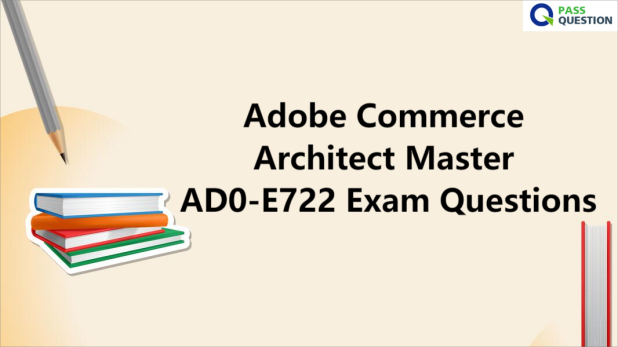Adobe Commerce Architect Master AD0-E722 Exam Questions
If you aspire to become an Adobe Commerce Architect Master, PassQuestion offers a wide range of resources to assist you in your journey. By selecting the latest Adobe Commerce Architect Master AD0-E722 Exam Questions, you can not only enhance your chances of passing the exam effortlessly but also boost your confidence to tackle any challenges that may arise during the examination. With PassQuestion Adobe Commerce Architect Master AD0-E722 Exam Questions, you can effectively prepare yourself for success.

Adobe Commerce Architect Master
Adobe Commerce Architect Master is a certification program offered by Adobe. It is designed for professionals who have advanced knowledge and expertise in architecting Adobe Commerce solutions. This certification validates the skills required to design and implement complex eCommerce architectures using Adobe Commerce. Achieving the Adobe Commerce Architect Master certification demonstrates a deep understanding of Adobe Commerce and the ability to architect scalable and secure eCommerce solutions. You should have at least 3-5 year experience leading Commerce development projects and are able to design, integrate, implement, and explain solutions to business problems by utilizing Adobe Commerce along with associated services.
Exam Details
Level: Master (3-5 years' experience)
Passing Score: 30/50
Time: 100 mins
Delivery: Online proctored (requires camera access)
Available languages: English
Cost: $225 (global) / $150 (India)
Exam ID: AD0-E722
Exam Objectives and Scope
This section provides information on the exam content.
Section 1: Design (46%)
- Design and implement optimal solutions for Adobe Commerce to meet business needs
- Design logical and technical flows
- Customize Commerce features
- Integrate Adobe Commerce with external systems and services
- Troubleshoot design flows
Section 2: Review (32%)
- Review and refactor existing Adobe Commerce customizations
- Utilize Commerce test frameworks throughout the whole workflow
- Optimize performance and scalability for Adobe Commerce
- Troubleshoot to identify the root cause of issues with Adobe Commerce
- Enforce coding standards
Section 3: Configure and Deploy (22%)
- Configure Adobe Commerce and make sure the project is set up optimally
- Configure all aspects of Adobe Commerce Cloud
- Oversee and improve deployment process
- Troubleshoot infrastructure and configuration issues
View Online Adobe Commerce Architect Master AD0-E722 Free Questions
1. An Adobe Commerce Architect is working on a scanner that will pull prices from multiple external product feeds. The Architect has a list of vendors and decides to create new config file marketplace.feeds.xml.
Which three steps can the Architect take to ensure validation of the configuration files with unique validation rules for the individual and merged files? (Choose three.)
A.Implement validation rules in the Converter class for the Config Reader
B.Create validation rules in marketplace.schema.xsd.
C.Provide schema to validate a merged file.
D.Add the Uniform Resource Name to the XSD file in the config XML file.
E.Provide schema to validate an individual file.
F.Create a class that implements \Magento\Framework\Config\Datainterface.
Answer: B, C, E
2. An Adobe Commerce Architect is supporting deployment and building tools for on-premises Adobe Commerce projects. The tool is executing build scripts on a centralized server and using an SSH connection to deploy to project servers.
A client reports that users cannot work with Admin Panel because the site breaks every time they change interface locale.
Considering maintainability, which solution should the Architect implement?
A.Modify project config.php file, configure 'admin_locales_for_deploy' value, and specify all required locales
B.Edit project env.php file, configure 'adminJocales_for_build' value, and specify all required locales
C.Adjust the tools build script and specify required locales during *setup:static-content:deploy' command
Answer: C
3. An Adobe Commerce Architect is planning to create a new action that will add gift registry items to the customer's quote. What should the Architect do to guarantee that private content blocks are updated?
A.Mark the controller by setting no-cache HTTP headers
B.Invalidate the status of gift registry indexers
C.Specify a new action in a sections.xml configuration file
Answer: C
4. An Adobe Commerce Architect needs to ensure zero downtime during the deployment process of Adobe Commerce on-premises. Which two steps should the Architect follow? (Choose two.)
A.Enable Config flag Under deployement/blue_green/enabled
B.Run bin/magento setup:upgrade --dry-run=true to upgrade database
C.Run bin/magento setup:upgrade - -keep-generated to Upgrade database
D.Run bin/magento setup:upgrad --convert-old-scripts-true to Upgrade database
E.Enable Config flag Under developer/zero_down_time/enabled
Answer: A, C
5. An Adobe Commerce Architect is troubleshooting an issue on an Adobe Commerce Cloud project that is not yet live.
The developers copied the Staging Database to Production in readiness to Go Live. However, when the developers test their Product Import feature, the new products do not appear on the front end.
The developers suspect the Varnish Cache is not being cleared. Staging seems to work as expected. Production was working before the database migration.
What is the likely cause?
A.Thefatlycredentials in the Production Database are incorrect.
B.A deployment should have been done on Production to initialize Fatly caching.
C.The site URLs in the Production Database are the URLs of the Staging Instance and must be updated
Answer: C
- TOP 50 Exam Questions
-
Exam
All copyrights reserved 2025 PassQuestion NETWORK CO.,LIMITED. All Rights Reserved.

